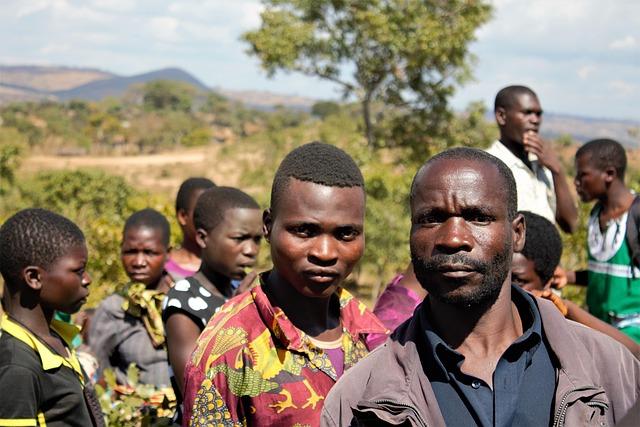As Malawi grapples wiht persistent economic challenges adn high rates of poverty, the need for effective social protection mechanisms has never been more pressing. In its latest report, the World Bank highlights a transformative approach to cultivating resilience among vulnerable populations in Malawi. By reimagining social protection strategies, the report underscores the potential to not only address immediate survival needs but also to empower communities, foster sustainable economic growth, and ultimately eradicate poverty. This article delves into the key findings and recommendations from the World Bank’s analysis, exploring how Malawi can harness its resources and innovate its policies to create a more equitable future for all citizens. As the nation stands at this critical juncture, the call for comprehensive social protection reforms emerges as a beacon of hope for millions striving for a better life.
Building a stronger Safety Net: Enhancing Social Protection in Malawi

Malawi stands at a pivotal point where the enhancement of its social protection system could serve as a cornerstone for national development. By investing in a robust safety net, the government can ensure that vulnerable populations are not only shielded from economic shocks but are also empowered to lead sustainable lives. Key strategies include:
- Expanding cash transfer programs: Increasing the coverage of programs that provide financial support to low-income families is essential for building resilience.
- Integrating social services: Linking social protection with health and education services can enhance access and improve outcomes for beneficiaries.
- Promoting community participation: Engaging local communities in the design and implementation of social protection initiatives ensures that programs are tailored to the unique needs of diverse groups.
To effectively transform the social protection landscape, Malawi could also consider data-driven approaches to identify and target those most in need. Utilizing technology to streamline beneficiary registration and monitoring can lead to greater efficiency and transparency.The following table illustrates potential benefits of a strengthened social protection system:
| Benefit | Description |
|---|---|
| Poverty reduction | Direct financial support helps lift families out of poverty. |
| Economic Stability | support during crises promotes economic resilience at the household level. |
| Improved Nutrition | cash transfers can enable families to purchase nutritious food. |
| Access to Education | financial support may alleviate barriers to school attendance for children. |
Empowering Communities: The Role of Local Involvement in Resilience Strategies

Local involvement is vital for building resilience in communities, especially in Malawi, where social protection efforts are crucial for poverty eradication. Engaging residents and local organizations can yield insights and foster solutions that are uniquely tailored to the community’s needs. By empowering local leaders and mobilizing community members, initiatives can harness collective knowledge and strength.this not only promotes ownership of resilience strategies but also encourages sustainable practices that are informed by local customs and experiences. Moreover, these grassroots efforts enhance trust and accountability, ensuring that support systems are effective and culturally relevant.
Moreover, collaboration between community members and local governments can create a robust network of support that enhances the effectiveness of resilience strategies. Through inclusive planning and decision-making,communities can identify their most pressing challenges and jointly develop targeted interventions. Funding opportunities can be maximized when local input is prioritized, leading to better allocation of resources. Examples of strong local involvement include:
- Community-led training programs that equip individuals with skills to cope with environmental changes.
- Support groups that provide emotional and financial assistance to vulnerable families.
- Local partnerships with NGOs to implement education and health initiatives.
These actions not only foster resilience but also weave a fabric of interconnectedness that strengthens the community’s capacity to thrive amid challenges. The inclusion of diverse voices in resilience planning is an essential element in crafting strategies that are both effective and enduring.
Investing in Education and Skills Development for Sustainable Growth

Investment in education and skills development plays a crucial role in fostering sustainable growth, particularly in malawi, where a large demographic of youth is poised to become the driving force of the economy. Strengthening the education system to ensure that it is indeed both accessible and relevant is essential. This can be achieved through:
- Enhancing Curriculum: Adapting educational programs to meet the current and future needs of the job market.
- Vocational Training: Expanding access to vocational and technical training that equips young adults with practical skills.
- Teacher Training: Investing in professional development for educators to improve the quality of teaching and learning.
Moreover, a multi-faceted approach that integrates private-sector partnerships can provide invaluable support in bridging the skills gap. Initiatives should focus on:
- Public-Private Collaborations: Creating alliances between businesses and educational institutions to align training with industry needs.
- Scholarship Programs: Offering financial aid for underprivileged students to pursue higher education and skills training.
- Digital Literacy: Promoting technology training to prepare students for today’s digital economy.
| Key Areas of Investment | Expected Outcomes |
|---|---|
| Curriculum Development | Improved job readiness |
| Vocational Programs | Higher employment rates |
| Teacher Training | elevated teaching standards |
Harnessing Technology to Improve Access and Efficiency in Social Services

innovative technologies have the potential to revolutionize the landscape of social services in Malawi, enhancing both access and operational efficiency. Leveraging mobile platforms and digital applications can streamline the distribution of aid, ensuring that support reaches vulnerable populations quickly and reliably. By creating integrated databases that track individuals’ needs and service demands, social service organizations can make more informed decisions, prioritize interventions effectively, and reduce redundancy in efforts. This can considerably alleviate the bureaucratic burden that often hampers service delivery, allowing for a more responsive and dynamic approach to social protection.
Furthermore, the use of data analytics and geographic information systems (GIS) can guide policymakers in identifying high-need populations and areas, thereby allocating resources more strategically. The implementation of automated systems to monitor service uptake and outcomes can foster greater transparency and accountability. Consequently, the community can actively participate in the feedback loop, influencing policy adjustments in real time. Consider these impactful technological strategies:
- Mobile cash Transfers: Direct support through mobile banking to minimize out-of-pocket costs.
- Online Registration Systems: Simplified enrollment processes for beneficiaries.
- Real-Time Monitoring: Use of apps for feedback collection and service improvement.
- E-Learning Platforms: Training programs for social workers to enhance skills and knowledge.
Strengthening partnerships: Collaborating with NGOs and the Private Sector

To tackle the multifaceted challenges of poverty and social protection, fostering collaboration between governmental entities, non-governmental organizations (NGOs), and the private sector emerges as a vital strategy. by pooling resources and expertise, these partnerships can create more robust support systems tailored to the unique needs of Malawian communities. Engaging with local ngos ensures that programs align with grassroots insights, while private sector involvement can introduce innovative solutions and investment opportunities. Such collaborations can lead to:
- Shared Resources: Combined funding and logistical support to optimize program reach and effectiveness.
- Innovative Approaches: The leveraging of private sector innovation to develop technology-driven solutions for social protection.
- Community Engagement: Enhanced outreach and responsiveness to local needs, informed by NGOs’ on-the-ground presence.
Moreover, structured partnerships can facilitate knowledge exchange and capacity building, leading to sustainable social protection mechanisms. For example,creating a platform where NGOs and businesses can collaborate on training initiatives will empower communities with essential skills and resources. Below is a simple portrayal of potential collaboration areas:
| Collaboration Area | Potential Impact |
|---|---|
| Resource Mobilization | Amplified funding for social programs |
| Skill Development | Increased employment opportunities |
| Innovation in Services | Effective and efficient delivery of aid |
Measuring Impact: Establishing Metrics for Success in Poverty Alleviation Initiatives

Establishing robust metrics is crucial for evaluating the effectiveness of poverty alleviation initiatives in Malawi. By setting clear, quantifiable benchmarks, stakeholders can assess progress and make informed decisions. Key performance indicators (KPIs) should encompass a range of factors, including:
- Income Growth: Measuring changes in household income to gauge financial improvement.
- Employment Rates: Tracking job creation and employment opportunities generated by social protection programs.
- Access to Education: Evaluating enrollment and retention rates in schools to ensure that education is accessible.
- Health Outcomes: Assessing improvements in health indicators such as child mortality rates and access to healthcare services.
- Food Security: Monitoring the availability of nutritious food and the reduction of hunger incidents among vulnerable populations.
Utilizing a multi-dimensional approach that encompasses these metrics enables a holistic view of progress. Additionally, creating an interactive dashboard can facilitate real-time data analysis and reporting. The following table illustrates potential target metrics and their corresponding success indicators:
| Metric | indicator | Target |
|---|---|---|
| Household income | Average income increase | 20% over 3 years |
| Employment Rate | New jobs created | 10,000 annually |
| Education Access | School enrollment rates | 95% of children enrolled |
| Health Outcomes | Reduce child mortality rate | by 30% in 5 years |
| Food Security | Reduction in food insecurity | by 50% within 4 years |
to sum up
the challenges Malawi faces in combating poverty are important, yet the potential for transformation through resilient social protection systems is equally compelling. The world Bank’s insights reveal that by enhancing existing programs and fostering a more inclusive approach, Malawi has the possibility to not only uplift its most vulnerable populations but also to stimulate sustainable economic growth.As the nation navigates its path towards resilience,a collaborative effort between government,civil society,and international partners will be crucial. By investing in social protection that empowers individuals rather than merely providing assistance,Malawi can pave the way toward a brighter future,ultimately ensuring that no one is left behind in the fight against poverty. Now is the time for action and innovation as Malawi embarks on this critical journey, redefining social support and building a foundation for lasting prosperity.







